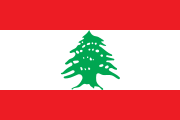Portal:Lebanon
The Lebanon PortalA view of Byblos, Lebanon
 Lebanon (/ˈlɛbənɒn, -nən/ ⓘ LEB-ə-non, -nən; Arabic: لُبْنَان, romanized: Lubnān, local pronunciation: [lɪbˈneːn]), officially the Republic of Lebanon, is a country in the Levant region of West Asia. It is bordered by Syria to the north and east, by Israel to the south, and by the Mediterranean Sea to the west; Cyprus lies a short distance away from the country's coastline. Lebanon's location at the crossroads of the Mediterranean Basin and the Arabian hinterlands has contributed to the country's rich history and shaped a unique cultural identity shaped by religious diversity. Lebanon has a population of more than five million people and covers an area of 10,452 square kilometres (4,036 sq mi). Lebanon's capital and largest city is Beirut, followed by Tripoli and Jounieh. While Arabic is the official language, French is also recognized in a formal capacity; Lebanese Arabic is the country's vernacular, though French and English play a relatively significant role in everyday life, with Modern Standard Arabic being limited to news and government matters. The earliest evidence of human civilization in Lebanon dates back to 5000 BCE. From 3200 to 539 BC, what was to become Lebanon was part of Phoenicia, a maritime empire that stretched the Mediterranean Basin. In 64 BC, the Roman Empire conquered the region, and Lebanon soon became a major center for Christianity under the aegis of the Byzantine Empire. In the 7th century, the Muslim conquest of the Levant brought the region under the control of the Rashidun Caliphate. The 11th century saw the beginning of the Crusades and the establishment of Crusader states, which later fell to the Ayyubids and the Mamluks, who in turn ceded the territory to the Ottoman Turks in the aftermath of the Ottoman–Mamluk War of 1516–1517. Under Ottoman ruler Abdulmejid I, the first Lebanese proto-state was established in the form of the Mount Lebanon Mutasarrifate, created in the 19th century as a home for Maronite Christians under the Ottoman "Tanzimat" period. Lebanon is a developing country, ranked 112th on the Human Development Index. It has been classified as an upper-middle-income state. The Lebanese liquidity crisis, coupled with nationwide corruption and recent disasters such as the 2020 Beirut explosion, have precipitated the collapse of Lebanon's currency and fomented political instability, widespread resource shortages, and high unemployment and poverty. The World Bank has defined Lebanon's economic crisis as one of the world's worst since the 19th century. Despite the country's small size, Lebanese culture is renowned both in the Arab world and globally, powered primarily by the Lebanese diaspora. Lebanon is a founding member of the United Nations and of the Arab League, and is a member of the Non-Aligned Movement, the Organization of Islamic Cooperation, the Organisation internationale de la Francophonie, and the Group of 77, among others. (Full article...) This is a Featured article, one of the best articles Wikipedia has to offer.
The Roman temple of Bziza is a well-preserved first century AD building dedicated to Azizos, a personification of the morning star in ancient Arab polytheism. This Roman temple lends the modern Lebanese town of Bziza its current name, as Bziza is a corruption of Beth Azizo meaning the house or temple of Azizos. Azizos was identified as Ares by Emperor Julian. The tetrastyle prostyle building has two doors that connect the pronaos to a square cella. To the back of the temple lie the remains of the adyton where images of the deity once stood. The ancient temple functioned as an aedes, the dwelling place of the deity. The temple of Bziza was converted into a church and underwent architectural modification during two phases of Christianization; in the Early Byzantine period and later in the Middle Ages. The church, colloquially known until modern times as the Lady of the Pillars, fell into disrepair. Despite the church's condition, Christian devotion was still maintained in the nineteenth century in one of the temple's niches. The temple of Bziza is featured on multiple stamps issued by the Lebanese state. (Full article...)Did you know (auto-generated) -
TopicsRelated portalsReligions in Lebanon Arab states This is a Good article, an article that meets a core set of editorial standards.
The Democratic Left Movement (DLM, Arabic: حركة اليسار الديمقراطي Harakat Al-Yassar Al-Dimuqratiy, Arabic acronym HYD) is a nonsectarian and a democratic leftist political party. It was founded in September 2004 by left-wing and center-left intellectuals and activists some of whom had previously split from the Lebanese Communist Party (LCP) while some were student activists from the "Independent Leftist Groups". The DLM affirms a European-style social democracy—but is open to all forms of leftism and encourages the development of a true secular state. The party operates under a decentralized framework that emphasizes diversity of thought for a progressive society in a liberal democratic environment. It participated in the 2005 Cedar Revolution, a wave of demonstrations against the Syrian occupation of Lebanon, and calls for correcting imbalanced relations with Syria. The DLM won its first parliamentary seat in Lebanon's 2005 elections representing the Tripoli district. On 2 June 2005, amid election rounds, Samir Kassir, a founder of the movement, was assassinated in a car bombing. Less than one month later, George Hawi, a former secretary general of the Lebanese Communist Party and an ally of the DLM, was killed in a similar car bombing in Beirut. In the 2009 elections, the party again won a single seat, instead representing the West Bekaa district. It is a member of the March 14 Alliance parliamentary coalition. (Full article...)General imagesThe following are images from various Lebanon-related articles on Wikipedia.
CategoriesAssociated WikimediaThe following Wikimedia Foundation sister projects provide more on this subject:
SourcesDiscover Wikipedia using portals |























































